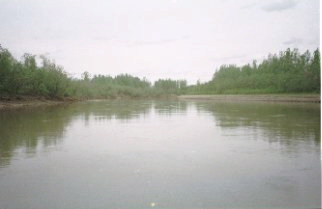

|
We spent a great deal of time on the land adjacent to Salchaket Slough. The Slough is a tributary of the Tanana River, one of the largest rivers in the Yukon Basin. The rivers in Interior Alaska tend to run shallow and wide. The brown color of the water is caused by glacial silt. Like many of the rivers in Interior Alaska, this one was largely fed by melting glaciers.
Because it was impossible to see through the brown water, We were forced to scan the surface for subtle clues about what lay beneath. In areas where water is shallow or submerged objects are located, the water will have a smoother appearance than it will in the deeper channels. By paying close attention, it is often possible to follow the river's channel. However, if there were strong winds and the water was choppy all over, anything could lay beneath the surface.
While sandbars can be hazardous, there are more serious things to worry about when running a
river. Of real concern are submerged logs and "sweepers." Logs that are submerged just below
the surface are dangerous because they can easily flip boats over. Sweepers are trees which
still have their roots attached to the stream bank but have their tops in the water. When boats
run into sweepers, the bow can be forced underwater. As the current pushes the boat forward,
the entire boat can be pushed under, killing or injuring the crew. In rivers as fast and cold
as those in the Arctic, the consequence of these hazards can be deadly.
 Return to Matt's Alaska Homepage
Return to Matt's Alaska Homepage
 Picture of the dogs.
Picture of the dogs.
Go to
Matt's Homepage About Chickadees
Go to the Gerbrandt Homepage
Text and all photographs Copyright © 1999 Matthew Gerbrandt
Web Design- Copyright © 1999 Matthew Gerbrandt
Revised -- October 17th, 2001